How Hygienic Commercial Kitchen Design Saves You Time and Money
Commercial kitchen hygiene is more important than ever following the outbreak of the coronavirus. Good kitchen hygiene is vital for the safety of both staff and diners, as well as for maintaining your health and safety obligations. But did you know that the right commercial kitchen design and construction is inherently more hygienic, whilst also being quicker and easier to clean?
Whether you are a small independent restaurant or large 5* hotel, investing time in the design process with a commercial kitchen design company ensures that hygiene is considered from the outset of your project.
There are several design features that can make your kitchen more hygienic by its very nature. These features can increase efficiency, reduce cleaning times and limit expenditure on chemicals.
In this blog we explore these design features, the key equipment that can help with hygiene, and the important role service and maintenance has.
Got a question? Fill out the form below to contact us and we will get back to you to discuss further.
Hygienic Commercial Kitchen Design Features
There are several design features that can be incorporated into your commercial kitchen design to make sure it is truly hygienic.
From creating fully seamless food preparation and cooking areas, to cook suites and modular equipment with a one-piece tops and plinthed flooring, these all help to prevent food traps, dirt and fluid ingress.
Explore all the commercial kitchen design features below to help get you started with a hygienic kitchen.
Fully Seamless Food Preparation Areas
One of the biggest causes of poor hygiene within a commercial kitchen is food and dirt traps between and behind equipment. To overcome this, you should consider creating a fully seamless kitchen.
- This starts with a design that incorporates fully integral and sealed equipment as part of the stainless steel fabrication, ensuring food and liquids cannot get into, behind or between kitchen equipment, even in a bespoke cook suite.
- Secondly, you should have seamless working surfaces. This is especially important for food preparation areas where raw and other foodstuffs such as flour will usually get between gaps.
Equipment should be siliconed to the wall with upstands to all sides. Coupled with the sealed equipment and welded fabrication, this means you only clean the surfaces you see, because the construction prevents the ingress of food and liquids to previously hidden areas and voids. This all saves the time and money involved in moving equipment to clean.
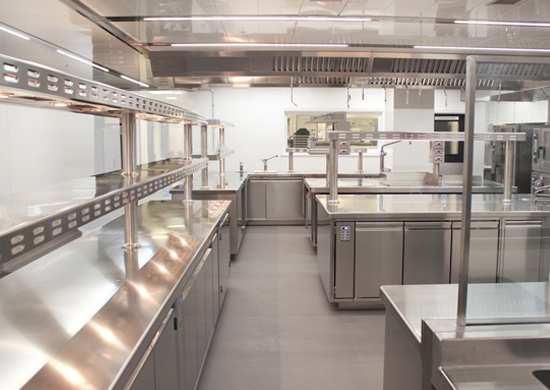
One-Piece Top Cook Suites and Modular Equipment
The pinnacle of a commercial kitchen is to have a fully bespoke cook suite with a one-piece stainless steel top. This immediately removes any gaps and dirt traps common with modular equipment.
However, bespoke cook suites, such as those from the class-leading DeManincor, can often be beyond the budgets of most restaurants or hotels. The good news is that there are several cost-effective or clever options to help you achieve a seamless cooking environment.
- Modular equipment and one-piece tops – Charvet (and other manufacturers) offers a range of modular equipment that is compatible with a one-piece top creating a cook suite that is cost effective.
- Equipment from the same manufacturer – An important consideration is to use modular equipment from the same manufacturer because their equipment normally follows the same dimensions and joins much more accurately. If you do not opt for a one-piece top, the equipment will naturally reduce the size of gaps.
- Infilling and sealing equipment – Utilising an infill behind equipment (where equipment stands off from the wall to allow for gas, electrical and waste services) further prevents dirt traps, reducing cleaning time behind the equipment.
But what about moving the equipment? Commercial kitchen equipment usually comes on wheels for ease of installation and cleaning behind. However, if the equipment is correctly installed with a fully seamless design, it negates the need to move it because food and liquids cannot get behind the equipment. Wheels are a solution to a problem that you can prevent.
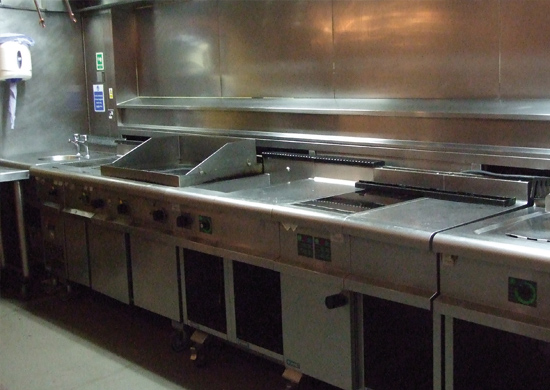
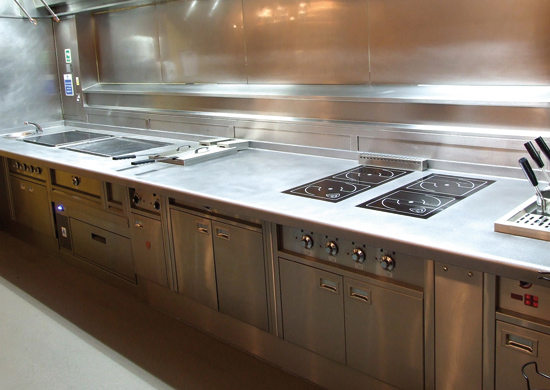
Plinthed Equipment and Hygienic Flooring
Raising your equipment, such as the cook suite or preparation counters, onto a plinth with the flooring coved up will remove any risk of poor hygiene under equipment.
Options for plinths include:
- Concrete – A concrete plinth is physically a solid option; however, it requires careful planning to ensure services such as electric, gas, waste and water are in the correct place.
- Hollow – Although a hollow plinth using steel or timber studwork may be considered less hygienic, by using coved-up flooring and sealed equipment (as described above), no dirt can get into the void.
Of course a more cost-effective option is to use steel toe kicks below equipment. However, this does not 100% prevent the ingress of dirt, and the toe kicks need to be removed in order to clean under the equipment. If this need is not passed on to new members of the team as part of the cleaning regime, it can easily be forgotten, as the equipment appears to be sealed and hygienic. This also increases floor cleaning time and cost. By having plinthed equipment, the floor is simply mopped up to the equipment, saving time and money.
When it comes to flooring, using a seamless solution like epoxy resin with a hard-wearing slip-resistant finish is the best for hygiene and safety. An Altro-style flooring is a more budget friendly option and easy to install to the plinths.
These options are both a lot easier to clean and often do not require harsh chemicals, unlike more traditional tiles and grout which are porous, resulting in lengthier cleaning times.
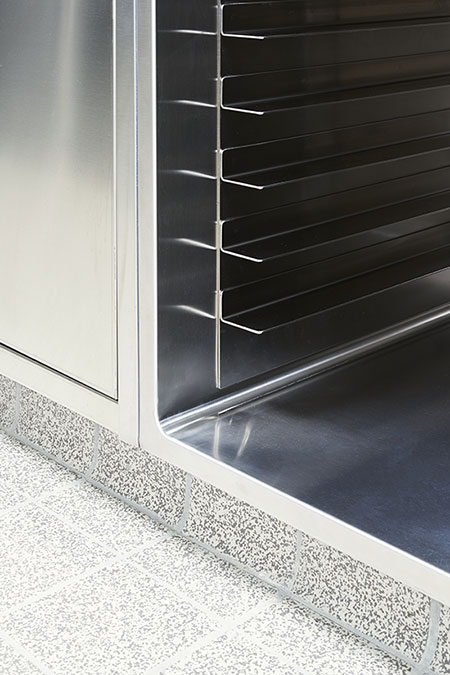
Need advice on creating a truly hygienic commercial kitchen?
Design and Layout of the Kitchen
The design or layout of the kitchen should not be overlooked when it comes to hygiene, which is particularly important when considering your obligations in terms of allergens and becoming COVID-Secure.
Having a fully seamless kitchen, as discussed above, makes it extremely easy to clean during service, helping to prevent cross-contamination of allergens or raw food with cooked food.
You should consider independent areas as part of the design to help with this, or fully enclosed areas where space allows.
Crossing paths within your kitchen is not only inefficient, with chefs spending more time walking or moving than they need to, but also a potential coronavirus hazard with the brigade not being able to maintain the one-metre plus rule.
Therefore, careful design planning that considers the ergonomics and flow or process of your cooking will ensure your kitchen is inherently more hygienic and potentially easier to clean during service.
Walls, Ceilings and Services
Often somewhat overlooked, your walls, ceilings and services can have an impact on your kitchen hygiene and the efficiency of cleaning.
- Walls should have seamless coverings, such as the Altro Whiterock – which is a highly versatile hygienic wall cladding – or, as an alternative, stainless steel panels.
- Ceiling options include a hygienic, food-safe suspended ceiling, which is easy to clean, or a fully ventilated ceiling where the panels can be put through the warewashing equipment for quick and labour-saving cleaning.
- Services such as gas, electric, water and waste should be considered as part of the kitchen design phase, to ensure that they are as concealed as possible.
You should try to bring the riser down from the wall in one place and encase it or chase into the walls. This eliminates the need for trunking or exposed pipework which will take longer to clean because of its intricacy and dirt traps. If pipework needs to be exposed, consider chrome pipework that is easier to keep clean and inherently more hygienic than copper.
Equipment to Help with Kitchen Hygiene
There is lots of commercial catering equipment that can help with your kitchen hygiene.
From induction equipment integrated into your cook suite to create a seamless and easy to clean surface, to equipment with self-cleaning functions to save you time and the important part warewashing, handwashing and storage can play.
Explore all the equipment below that can help create a truly hygienic commercial kitchen.
Induction Cooking Equipment
One of the most costly parts to clean in the kitchen is the cooking equipment. Gas is a firm favourite with chefs; however, it has drawbacks including the many components you must remove to clean and the fact that it retains heat.
Induction cooking equipment can be seamlessly integrated into surfaces (whether as part of a bespoke cook suite or modular equipment) and has no retained heat.
This means that chefs can wipe down as they go, resulting in no burnt-on food or carbon build-up on the cook top or pans. As a result, the clean at the end of service is much quicker, saving time, and requires no harsh chemicals.
Induction also has the benefit of using less energy, further reducing costs, as it is only on when needed. This, in turn, reduces ambient heat in the kitchen, resulting in a better working environment for the brigade.
As an example, the kitchen fitted in the Oxo Tower Restaurant has dramatically improved the cleaning process. According to Jeremy Bloor, Executive Head Chef, having induction hobs and integrated equipment with no joins and with everything flush has not only improved hygiene in the kitchen, it has also made cleaning a seamless process.
It has considerably reduced the amount of time required to clean the kitchen – cleaning is now completed within 20 minutes at the end of each service, instead of a lengthy overnight clean being required; the night cleaners now focus on cleaning the filters and the ceiling.
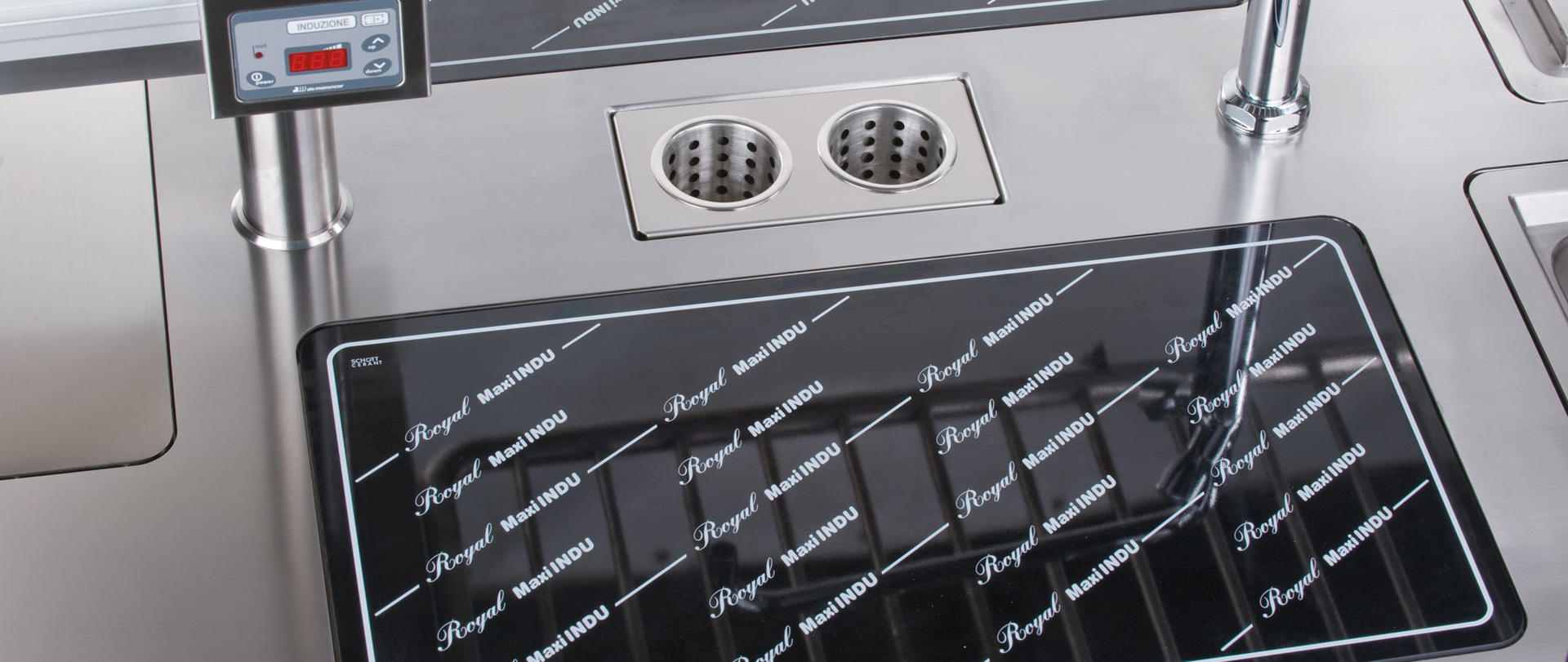
Shelving & Storage
Often overlooked, shelving and storage is a key area that can be susceptible to poor hygiene or involve spaces that are difficult and time consuming to clean.
Although chrome wire shelving can be specified with antibacterial coating, the wire is difficult to clean with dirt traps in many corners and joins.
A great alternative is polycarbonate shelving from Tournus. The manufacturer states: “The shelving is awarded the NF food hygiene quality mark. The shelving is made of food-grade materials and has smooth surfaces, with no lumps or nooks. No food matter can get trapped and they are machine washable.”
Being able to put the shelves into a warewashing machine saves significant time in the cleaning process.
Other features you should consider with shelving or storage, particularly in the main kitchen, are:
- Bracketless wall shelves – These shelves appear to be floating, and no brackets means no dirt traps, so they are far easier and quicker to clean.
- Double-skinned shelves – Steel shelves are often made of a single piece of sheet metal with curves and recesses underneath. A double-skinned shelf is fully enclosed, meaning there are no voids or hidden areas where dirt can build up.
Warewashing Equipment
It may sound obvious, but the appropriate warewashing equipment is vital to maintaining a high level of hygiene within your kitchen.
Most importantly, you want to ensure any warewashing equipment – such as dishwashers, utensil or pot washers and glass washers – are running at the correct temperature, preferably in excess of 60 degrees to eliminate the coronavirus. This should also be checked as part of any kitchen equipment recommissioning process.
Choosing the correct warewashing equipment can save space, time and money. For example, the modern GRANULDISK range of machines are dishwashers that use PowerGranule technology. This means you can “clean pots and pans in two minutes without pre-washing”, so you require fewer sinks in the kitchen. The GRANULDISK machines also use less chemicals than other types of machines.
GRANULDISK states:
“By using high temperatures to secure hygienically safe wash results instead of overdosing with chemicals, GRANULDISK provides a more sustainable washing operation that provides a healthier environment – both inside your washroom and in terms of keeping the environment clean.”
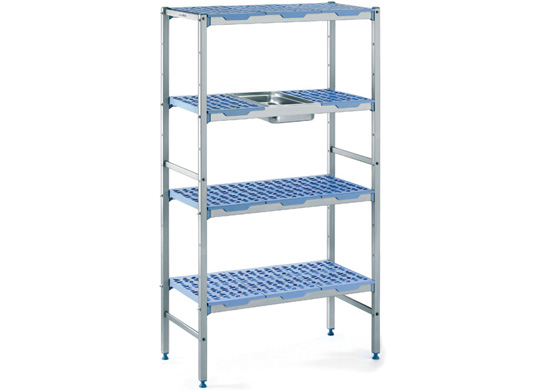
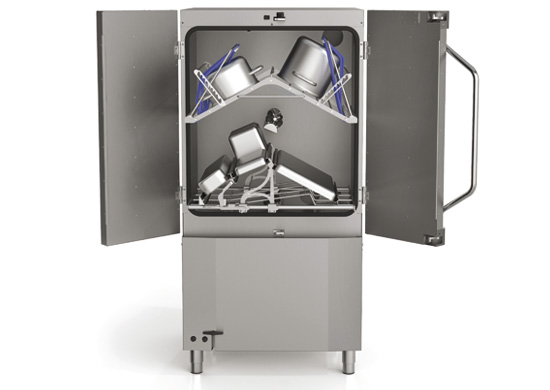
Refrigeration
This is another key area that can contribute to a hygienic restaurant or hotel kitchen.
Of course, there will be regular internal cleaning of the refrigerator or freezer, but have you considered the equipment’s mechanical parts?
We recommend using remote refrigeration packs. This ensures that there are minimal mechanical parts within the kitchen and, therefore, minimal areas for dirt and dust to collect.
By removing the condenser from the kitchen, you will be able to increase the internal dimensions of the fridge, boosting capacity whilst removing any dirt traps behind grills that must be regularly cleaned.
Blocked condensers and grills are also a big maintenance issue.
Remote refrigeration packs increase space and reduce maintenance and cleaning times, as well as offering the added benefit of reducing ambient heat in the kitchen.
Handwashing
As handwashing is a vital part of maintaining kitchen hygiene, having enough wash stations in your kitchen is a necessity and, therefore, an important part of kitchen design. A great design will incorporate enough handwashing stations that are positioned to help improve kitchen hygiene as well as the ergonomic flow of activities.
You should also consider taps that do not have to be touched by hands, such as:
And now, as a result of social distancing requirements, it is more likely that customers will want to sit outside to eat, so incorporating mobile hand wash basins for staff use in your outdoor seating areas will reassure customers that your restaurant continues to take hygiene seriously as part of its commitments to becoming COVID-Secure.
Interested in installing new hygienic kitchen equipment?
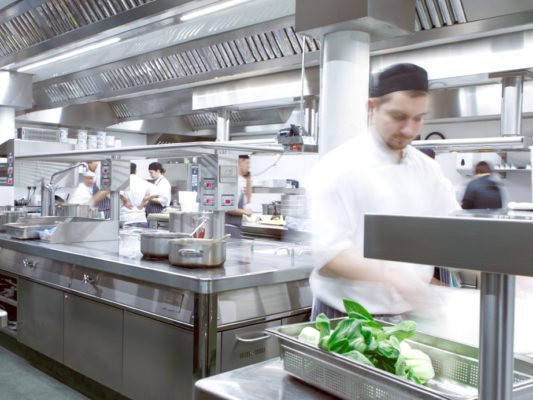
UV Filters for Grease Management
Keeping your ventilation clean and hygienic in your commercial kitchen allows you to prevent and eliminate problems which may affect the efficiency of your system!
UV filters in your ventilation can help to reduce fire risks and whilst also increasing your hygiene.
These systems are capable of breaking down grease and fats into small molecules like H2O and CO2. The benefits of having a UV filter in your extraction are:
- Elimination of bad odours
- Reduction of grease deposits
- Quick and easy cleaning as it requires less chemicals
- Reduced maintenance costs
Fryers and Other Cooking Equipment
When specifying equipment for your hygienic commercial kitchen, you will want to consider how easy equipment is to clean.
For example, you should consider a fryer that has removable or hinged elements, tank and batter plate. This makes it easier not only to dispose of old oil, but also to clean the machine, keeping hygiene at a high level.
This type of equipment may involve a minor price premium; however, this is far outweighed by a much quicker cleaning process.
So, when making your purchasing designs, look for the features that have been added to the equipment to aid cleaning, as much as how well it cooks food.
Self-Cleaning Equipment
Investing in equipment that has self-cleaning functions means you can carry out more regular cleaning, such as during service, to remove allergens or ensure no cross-contamination if you are catering for vegetarians, vegans or meat-eaters.
This also ensures that food build-up does not become significant on equipment, making deep cleans quicker and easier to carry out.
It is well worth investing in the latest innovative catering equipment with the most modern self-cleaning functions – such as the new iCombi Pro and iVario Cooking Centers – as technological advances often result in the use of less water, energy and chemicals.
Air and Surface Sterilisation Units
Even before COVID-19 became a part of our lives, hygiene was hugely important, but it is now a vital element in persuading customers to come back to your restaurant. The tried-and-tested HyGenikx Air & Surface Hygiene Steriliser kills biological hazards such as Salmonella, E. coli, Norovirus and Listeria.
The HyGenikx system has been tested and proved to eradicate MS-2 coliphage, a non-enveloped virus which is more difficult to kill than the lipid-enveloped SARS-CoV-2 (Coronavirus/COVID-19).
An additional benefit is that the elimination of bacteria has a knock-on effect on food freshness, resulting in less food waste.
Hygiene and Commercial Kitchen Equipment Maintenance
Just as important as the design and equipment within your hygienic commercial kitchen is the ongoing servicing and maintenance.
Regular commercial kitchen servicing supported by a Planned Preventative Maintenance contract can ensure that all your equipment is safe, fit for use and running efficiently.
Poor hygiene can cause breakdowns and more costly repairs. Suitably qualified catering equipment engineers will also highlight areas of poor hygiene and concern that may go unnoticed when taking equipment apart to service it.
Regular Servicing & Maintenance
Regular servicing and maintenance of your equipment will not only increase its efficiency and keep everything running smoothly, it will also improve hygiene.
Suitably qualified commercial kitchen engineers will highlight areas of poor hygiene that are in turn causing poor performance, such as dirty seals to ovens or blocked refrigeration condensers.
One of the most common breakdown call-outs our catering equipment engineers attend is blocked pilot thermocouples on gas cooking equipment. So, you will save time and money on these unnecessary breakdowns by using an alternative heat source, such as induction technology.
A great example of the importance of regular servicing and maintenance is the need to ensure that your warewashing equipment is always running at a high enough temperature to kill viruses – vital at the best of times, but an absolute necessity at the moment in order to eradicate the COVID-19 virus. You can find out more about the procedures you should take with warewashing in our guide to recommissioning your kitchen.
By investing in a Commercial Kitchen Planned Preventative Maintenance programme you will ensure that your cooking equipment will be not only reliable and efficient, but clean and hygienic too.
Commercial Kitchen Hygienic Design Help!
We hope that this blog has given you an insight into how to create a hygienic commercial kitchen through design.
It is important to remember that hygiene should be considered from the very outset of the design process to ensure you can create as seamless a kitchen as possible, preventing dirt and food traps.
You can then begin to specify equipment that is inherently more hygienic or has features to aid cleaning.
Ultimately, commercial kitchen design should play a key role in reducing the costs and time associated with cleaning your kitchen.
So, if you need assistance adapting your existing kitchen or designing a brand-new kitchen, please fill in the form below and we will arrange a complimentary design consultation to get you started.

